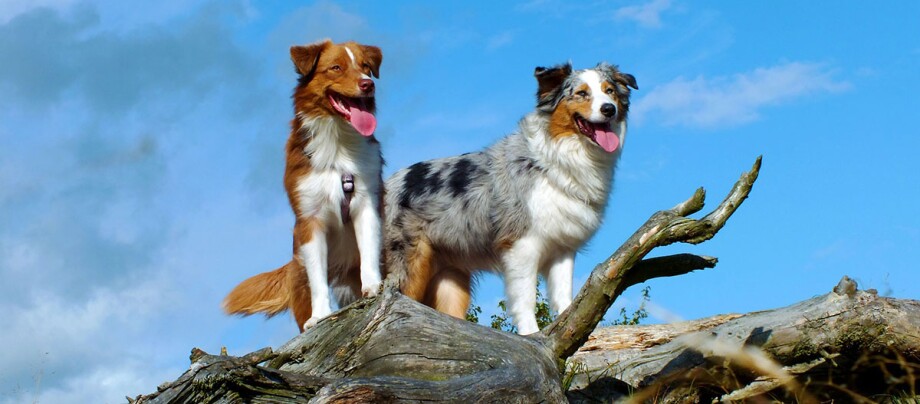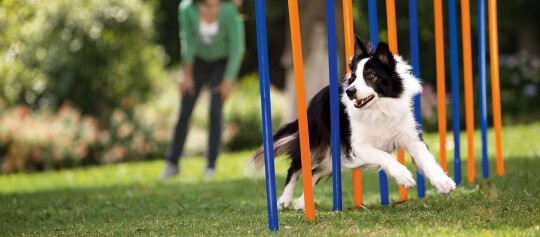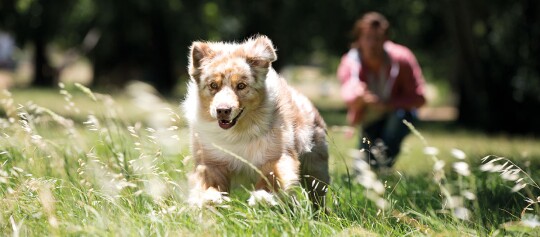Australian Shepherd – high-energy workaholic with demands
27.02.2024 - Reading time: 11 minutes

This four-legged friend is a live-wire: If you are looking for a family pet or an easy-going companion, the Australian Shepherd is not the right dog for you. This spirited workaholic wants to work or be kept busy, even to the point of exhaustion – or more specifically, that of its owner. If you are an experienced dog owner and are able to offer enough in the way of breed-appropriate activities, the Australian Shepherd will make an active, loyal dog. Here you can learn all the most important facts about the Australian Shepherd, from puppy to adult, and about Mini Australian Shepherds.
- The American that came from Australia
- Nature and character: Is an Australian Shepherd ideal for first-time owners?
- Australian Shepherd profile
- Is an Aussie a family dog?
- How long can I leave my Australian Shepherd by itself?
- Is an Australian Shepherd hard to train?
- How much exercise does an Australian Shepherd need?
- Australian Shepherds: What colours do they come in and what do I need to consider?
- Mini Australian Shepherd – how does it differ from the larger version?
- How much does an Australian Shepherd cost?
- Where can you buy an Australian Shepherd?
- Australian Shepherd care, diet and health
- What you should consider when buying an Australian Shepherd
The American that came from Australia
Its name can cause confusion, because the Australian Shepherd is not actually an Australian breed But things are a little more complicated than that: At the turn of the 20th century, the exportation of sheep from Australia to the USA was flourishing. The flocks were managed by trained herding dogs. These clever four-legged friends won over many fans in the States who then bred them, but it was not until 1957 that the first stud book was established there, with a binding breed standard put in place in 1977. The breed was not officially recognised by the FCI until 1996; in Europe, these beautiful animals have been widespread since the 1970s. The FCI classifies dogs into different groups and sections. The Australian Shepherd in placed in Group 1: Sheepdogs and cattledogs. The Shetland Sheepdog and Collie also belong to the same FCI group. In addition to the standard Aussie, which has a shoulder height of 46 to 58 centimetres, there are also Mini Australian Shepherds, which are about 10 centimetres smaller.
Nature and character: Is an Australian Shepherd ideal for first-time owners?
Training an Australian Shepherd may prove to be a challenge for first-time owners. It is very willing to learn and keen to please its owner – but this does not mean that it is easy to train. Any first-time owner planning to get an Australian Shepherd would be wise to seek the help of a dog training school or dog trainer, for example. Although the Australian Shepherd is quick to learn commands, it is equally quick at picking up bad habits. You will need to have patience, be loving and consistent, and adopt a straightforward approach. Otherwise, your dog is very likely to take advantage of any mistakes or slip-ups.
NewsletterAustralian Shepherd
Breed | Australian Shepherd |
Origin | USA |
Classification | sheepdog and cattledog |
Size | males 51 to 58 cm at shoulder height – females 46 to 53 cm at shoulder height |
Weight | 16 to 32 kilograms
|
Physique | medium sized, well proportioned, slightly longer than tall, sometimes with a natural bobtail
|
Eyes | medium-sized, almond-shaped; blue, amber or brown, possibly also flecked, marbled or in different colours
|
Ears | triangular folded ears with rounded tip
|
Coat and colour | semi-long coat with dense, weatherproof undercoat; basic colours: black, red, blue merle, red merle; all of which can be accompanied by white and copper markings |
Special features | the combinations of basic colour and sometimes also markings result in a total of 16 different recognised colour variations |
Nature | alert, intelligent, quick to learn, tireless, driven |
Care | brush once a week, or daily when shedding |
Health | must be tested for PRA and CEA before they are eight weeks old, be sure to visit a reputable breeder who does not allow merle-merle matings, as genetic diseases are prevalent in these cases, susceptible to bite defects |
Is an Aussie a family dog?
The Australian Shepherd can make a suitable family dog, but only in certain circumstances. Anyone planning on getting an Australian Shepherd as a family dog should first think about if this breed of dog will be able to integrate well into day-to-day family life. To ensure that everyone is able to live together harmoniously and that your Australian Shepherd puppy grows up to be a well-rounded dog, you should definitely plan to spend plenty of time with it, because if the Aussie is not sufficiently challenged or has to be left alone for long periods of time, there is a risk that it will develop undesirable behavioural problems. Its intense desire to keep busy sometimes makes it difficult for it to properly relax. If it becomes too bored, it will often be your furniture that suffers the consequences. If an Aussie is to become your new family member, it is also advisable to impress upon your children the importance of consistent training. The younger children are, the harder it is for them to consistently stick to the rules. Older children or teenagers may find it easier to play a part in helping to train their dog.
Many people see the Australian Shepherd as a strong-willed, stubborn breed that is difficult to train. However, these characteristics do not generally make it unsuitable as a family dog, as it also possesses numerous virtues: being a sheepdog, it is alert and intelligent, as is to be expected of herding breeds. It is always loving and friendly towards those it trusts. It can take a little longer for it to be trusting and approachable with strangers. It is very keen to please its owner and complete the tasks it has been set. If these qualities are shaped through correct training, you are sure to end up with a wonderful, and family-friendly, companion.
If, on the other hand, your dog is not sufficiently exercised, its strong instinct to watch and herd can sometimes manifest itself in undesirable behaviours: it may turn to rounding up joggers, playing children, cyclists and other pets to satisfy its urge to herd.
How long can I leave my Australian Shepherd by itself?
The question of how long you can leave your Australian Shepherd by itself has no simple answer. Firstly, your dog’s age plays a key role: Australian Shepherd puppies cannot (and should not) be left alone. You should be able to leave an adult dog unsupervised for periods of time. Whether this is for one hour, or even three hours, depends on the individual dog. The key things is making sure that all of your dog’s needs are fully met. Under no circumstances can you leave an Australian Shepherd (and ideally any dog) by itself for more than four hours. Likewise, a dog of this breed does not make a good companion that you can take to the office with you for the whole day.
Is an Australian Shepherd hard to train?
The success with which an Australian Shepherd can be trained depends primarily on the experience and consistency of its owner. If you provide your dog with mental and physical stimulation, can be patient with training and treat your dog in a straightforward, loving and consistent way, you will find it to be a well-behaved, loyal companion.
How much exercise does an Australian Shepherd need?
Let’s be clear: Australian Shepherds are real live-wires! Inexperienced owners will quickly discover how spirited they can be when not given enough exercise. Owners have to be able to spend enough time with their dog.
The German Animal Welfare Dog Ordinance states that owners should allow their dog to exercise outdoors for at least one hour twice a day – even though this is a legal framework, this would be nowhere near enough for a dog of this breed. You should make sure that an Australian Shepherd gets outside at least three times a day to ensure it is getting several hours of exercise each day.
You Aussie requires a good mix of both physical exertion and mental stimulation, such as tracking or mantrailing. People who enjoy jogging, cycling, hiking or long walks make ideal owners for this breed. As Australian Shepherds also love to be mentally challenged, you will also find these dogs working as search and rescue and drug detection dogs, as well as guide dogs, because these are roles in which its intelligence and eager nature really shine through. The dog’s stamina can sometimes push you to your limits: even a full programme of agility and games of fetch will not tire them out. Tracking games present a greater intellectual challenge for your dog. The biggest challenge when training an Australian Shepherd is teaching them when it is time to rest and finding the right balance between activity and relaxation. Achieving this requires time, patience and empathy.
The Australian Shepherd is not suitable for older people who may have physical limitations to consider and those who work and cannot leave their workplace for many hours at a time.
Australian Shepherds: What colours do they come in and what do I need to consider?
Australian Shepherds come in a wide range of coat colours. Common colours are:
- Black tri: Mostly black, with white and copper markings
- Black bi: Mostly black, with white markings
- Red tri: Mostly brown, with white and copper markings
- Red bi: Mostly brown, with white markings
- Blue merle: Mostly blue merle (lighter grey, mottled), with white and copper markings
- Red merle: Mostly red merle (lighter brown, mottled), with white and copper markings
- Blue and red merle without any markings or with white markings
Extra consideration must be given to the health of dogs with merle coats, as dogs which carry the gene for the merle colouring are at higher risk of certain diseases: these include impaired hearing and vision, an impaired sense of balance and infertility. There is a high risk that the offspring of Australian Shepherd parents who both carry the merle gene will develop these problems. In Germany, it is therefore illegal to breed dogs that both carry the merle gene. This also applies to Mini Australian Shepherds and other dog breeds with the merle coat colouring.
Mini Australian Shepherd – how does it differ from the larger version?
The only difference between Mini Australian Shepherds and ‘standard’ Australian Shepherds is in fact their size. While males of the classic variety can reach a height of up to 58 centimetres at the shoulders, and females up to 48 centimetres, Mini Australian Shepherds are around ten centimetres smaller on average. The smaller Aussies come in the same colours as their larger cousins. The most important thing to know is that the character of Mini Australian Shepherds is no different to that of the standard version. Some people believe that the “Minis” are more suitable for a small apartment or as a family dog because of their manageable size. However, this is not the case: Mini Australian Shepherds are also very high-energy dogs that require plenty of activity, exercise and careful training.
How much does an Australian Shepherd cost?
Australian Shepherds are popular – and like most other sought-after breeds, this is reflected in the price. An Australian Shepherd puppy usually costs anywhere between 1,300 and 2,500 euros.
Where can you buy an Australian Shepherd?
A pedigree dog like the Australian Shepherd or Mini Australian Shepherd can be purchased from a breeder. It is important to make sure that they are reputable. Don’t be pressured into making a quick decision if you are looking to buy an Australian Shepherd puppy. Reputable Australian Shepherds breeders care about the health and well-being of the dogs. Ideally, the animals live with the family and not alone in a kennel. The environment should appear clean and hygienic, and the parents’ papers and health certificates should be available to view. A reputable breeder will be more than happy to answer all your questions, and it goes without saying that you should also be able to meet the puppies’ mother. The breeder should also be interested in making sure that you will be able to meet the dog’s needs. In order to ensure that Australian Shepherd puppies are well socialised, the breeder should not hand over the puppies before they are twelve weeks old.
Australian Shepherd care, diet and health
The Australian Shepherd’s coat is very easy to care for. A weekly brush is enough to remove any loose undercoat, or daily if the dog is currently shedding. The life expectancy of an Australian Shepherd is 12 to 15 years. The breed is unfortunately prone to hereditary diseases and disabilities such as deafness and blindness. Make sure that you are purchasing your puppy from a responsible breeder. Due to the dog’s growing popularity, more unregulated breeding is taking place. Hip and elbow dysplasia as well as malocclusions, eye diseases and epilepsy are some of the diseases typically seen in the Australian Shepherd breed.
A dog’s diet should be adapted according how much physical exercise it gets. A balanced proportion of carbohydrates helps to provide energy, especially for active animals. A dog’s nutritional requirements are determined by its size, weight, age and activity levels. Additional treats, used as a reward or training incentive, should also be included in its daily food intake. If you are unsure, ask your vet which diet is right for your Aussie.
What you should consider when buying an Australian Shepherd
Due to its high-energy nature, the Australian Shepherd is not the right dog for everyone. Before buying one, you should think carefully about whether you can meet the high demands of this breed and be aware that the whole family needs to work together when it comes to training. Look for a reputable breeder who helps to ensure that the animals are well socialised from a very early age. Nowadays, most Australian Shepherds are kept as family or companion dogs. However, in many places they are still used as working sheepdogs. As such, there are both working lines and dogs that have been bred to have a somewhat more relaxed temperament. Therefore, make sure to ask the breeder about the characteristics they breed for to ensure you find the right dog for your lifestyle and activity level.

